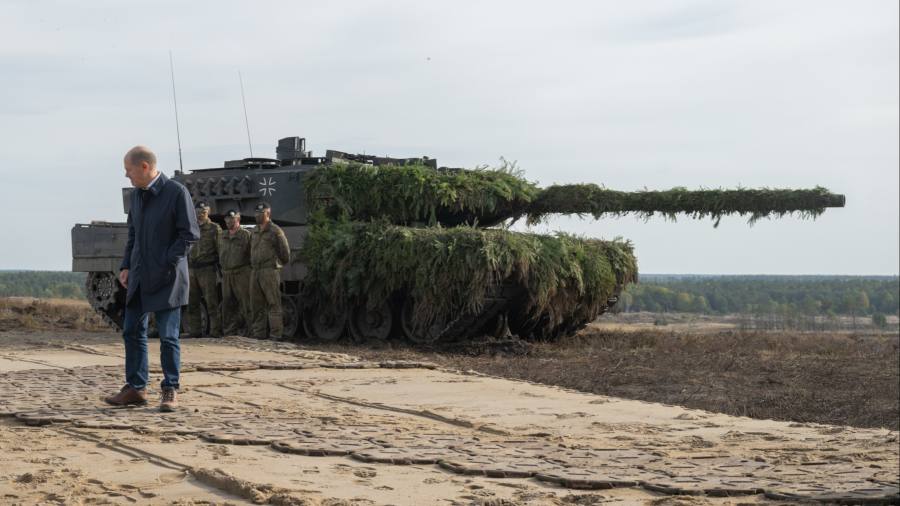[ad_1]
Olaf Scholz is under growing international pressure to make a momentous decision: whether or not to give the green light for German battle tanks to be sent to Ukraine.
Berlin’s western allies have been turning the screws on the German leader as Kyiv pleads for more weapons to consolidate its gains against Russia and recapture occupied territory as the war approaches its first anniversary.
Public statements by leading German ministers in recent days suggest that the government’s position is shifting. But Scholz, who is the ultimate decision maker, has yet to indicate a change of heart.
The German chancellor wields huge influence not only because of the military and political ramifications of a decision by Europe’s most populous nation and largest economy to dispatch its own tanks to Ukraine. He also has authority to approve or veto the re-export of the German-made Leopard 2 tanks that are used by 13 armies across Europe.
Yet Scholz, known for his cautious style, has for months voiced hesitancy about supplying tanks even as the Green and liberal partners in his three-way coalition have grown bolder in their support for doing so.
“Germany should . . . not stand in the way if other countries decide to support Ukraine, regardless of whatever decision Germany itself makes,” Green economy minister Robert Habeck said on Thursday.
While Scholz last year promised a “sea change” in Germany’s defence and security policy in response to Vladimir Putin’s invasion of his neighbour, that shift has appeared slow to Kyiv and its most vocal allies in Europe including Poland and the Baltic nations.
“It’s always a similar pattern: First they say ‘no,’ then they fiercely defend their decision, only to say ‘yes’ in the end,” Ukraine’s foreign minister Dmytro Kuleba said this week. “We are still trying to understand why the German government is doing this to itself.”
Senior figures in Scholz’s Social Democratic party (SPD) deny that the chancellor is too hesitant. “I don’t see it as dithering,” Michael Roth, head of the Bundestag’s foreign affairs committee, told German radio on Friday. “He is proceeding cautiously, in a way that takes account of the fact that [German] society is split on this issue.” There were, he said, “no clear majorities” in favour of sending tanks to Ukraine.
The German leader has repeatedly voiced concern over his country being perceived as escalating the conflict and provoking Putin, who has hinted he could resort to nuclear weapons. Recent polls suggest a majority of Germans are opposed to supplying Ukraine with Leopard 2 tanks.
Scholz is not helped by the political baggage of his SPD, which has a long history of pacifism and a record of promoting closer ties with Russia. However, Rolf Mützenich, head of the party’s parliamentary group, said on Thursday that when it came to sending battle tanks to Ukraine, “there are no red lines”.
The German leader’s position on sending weapons to Ukraine has shifted since the start of the war. Initially he refused to send any heavy arms at all, saying his country would not “go it alone”. But then Berlin began to deliver armoured vehicles, self-propelled howitzers and air defence systems.
Last week he and Joe Biden, the US president, announced they would deliver infantry fighting vehicles: the US-made Bradley and German-made Marder. The move came a day after French president Emmanuel Macron said France would provide AMX-10 armoured vehicles — considered by some military analysts as “light tanks” — to Ukrainian forces.
In an apparent attempt to up the pressure on Berlin, Britain announced this week that it was working on plans to send a small number of Challenger 2 tanks to Kyiv.
Poland’s president Andrzej Duda also announced plans to send 14 Leopard 2 tanks to Ukraine’s army “as part of the building of an international coalition” — a step that would only be possible with German approval. A spokesman for Scholz said on Thursday that Berlin had not yet received a formal request to re-export German-made tanks.
US officials remain more cautious. While they have said that they are discussing the prospect of sending tanks to Ukraine, such a move does not seem imminent. Some view German-made Leopards as a better option for Kyiv because they are lighter and easier to maintain than American-made Abrams.
Yet Scholz may only be able to act on tanks if he can do so in lock-step with the Americans. “He needs the cover of a nuclear power,” said Jana Puglierin, senior policy fellow at the European Council on Foreign Relations. “A European consortium might not be enough for him.”
Scholz’s reluctance has both confounded and angered his critics. Roderich Kiesewetter, a member of the Bundestag foreign affairs committee from the opposition Christian Democrats (CDU), accused the chancellor of surrounding himself with “Russia romantics” who “want to sacrifice Ukraine”. Kiesewetter welcomed the statements from Warsaw and London and called on Berlin to “finally rethink its position” on tanks, adding: “We’ve been far too cautious.”
Marie-Agnes Strack-Zimmermann, the Free Democratic party (FDP) chair of the Bundestag’s defence committee and a prominent Russia hawk, suggested that the SPD leadership had misunderstood the meaning of pacifism. “If you see the aggression of Russia and you see how brutal the fighting against Ukraine is, it’s not un-pacifist if you try to protect yourself.”
The “terrible” destruction inflicted by German tanks on the Soviet Union — which included Ukraine — in the second world war still cast a long shadow in her country, she said. But history, she argued, could be used to make a positive case for sending tanks. “You could . . . say that German tanks, German soldiers were a nightmare for the Ukrainian people in the second world war, and now this materiel is not a nightmare any more — it’s to help Ukraine.”
Additional reporting by Felicia Schwartz in Washington
[ad_2]
Image and article originally from www.ft.com. Read the original article here.

